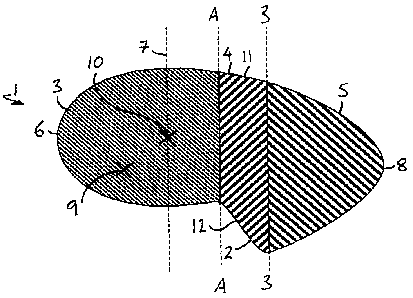Some of the information on this Web page has been provided by external sources. The Government of Canada is not responsible for the accuracy, reliability or currency of the information supplied by external sources. Users wishing to rely upon this information should consult directly with the source of the information. Content provided by external sources is not subject to official languages, privacy and accessibility requirements.
Any discrepancies in the text and image of the Claims and Abstract are due to differing posting times. Text of the Claims and Abstract are posted:
| (12) Patent: | (11) CA 2545888 |
|---|---|
| (54) English Title: | ROWING OR SCULLING OAR HANDLE |
| (54) French Title: | POIGNEE D'AVIRON DE POINTE OU DE COUPLE |
| Status: | Deemed Expired |
| (51) International Patent Classification (IPC): |
|
|---|---|
| (72) Inventors : |
|
| (73) Owners : |
|
| (71) Applicants : |
|
| (74) Agent: | SMART & BIGGAR LP |
| (74) Associate agent: | |
| (45) Issued: | 2013-08-20 |
| (22) Filed Date: | 2006-05-05 |
| (41) Open to Public Inspection: | 2006-11-05 |
| Examination requested: | 2011-04-26 |
| Availability of licence: | N/A |
| Dedicated to the Public: | N/A |
| (25) Language of filing: | English |
| Patent Cooperation Treaty (PCT): | No |
|---|
| (30) Application Priority Data: | ||||||
|---|---|---|---|---|---|---|
|
A rowing or sculling oar handle in which when the handle is orientated for a stroke it has an axial cross-sectional shape with a greater horizontal extent than vertical extent, and in which an underside of the axial cross-sectional shape is provided with an abutment.
Une poignée d'aviron de pointe ou de coupe où, lorsque la poignée est orientée pour un coup, celle-ci adopte une forme de coupe plus grande à l'horizontale qu'à la verticale, et où une sous-face de la forme de coupe axiale est fournie avec un aboutement.
Note: Claims are shown in the official language in which they were submitted.
Note: Descriptions are shown in the official language in which they were submitted.

2024-08-01:As part of the Next Generation Patents (NGP) transition, the Canadian Patents Database (CPD) now contains a more detailed Event History, which replicates the Event Log of our new back-office solution.
Please note that "Inactive:" events refers to events no longer in use in our new back-office solution.
For a clearer understanding of the status of the application/patent presented on this page, the site Disclaimer , as well as the definitions for Patent , Event History , Maintenance Fee and Payment History should be consulted.
| Description | Date |
|---|---|
| Letter Sent | 2024-05-06 |
| Letter Sent | 2023-11-06 |
| Letter Sent | 2023-05-05 |
| Inactive: COVID 19 - Deadline extended | 2020-05-14 |
| Inactive: COVID 19 - Deadline extended | 2020-04-28 |
| Maintenance Request Received | 2020-04-23 |
| Common Representative Appointed | 2019-10-30 |
| Common Representative Appointed | 2019-10-30 |
| Maintenance Request Received | 2019-05-03 |
| Maintenance Request Received | 2018-05-04 |
| Change of Address or Method of Correspondence Request Received | 2018-03-28 |
| Maintenance Request Received | 2017-04-27 |
| Grant by Issuance | 2013-08-20 |
| Inactive: Cover page published | 2013-08-19 |
| Pre-grant | 2013-06-06 |
| Inactive: Final fee received | 2013-06-06 |
| Notice of Allowance is Issued | 2013-02-07 |
| Letter Sent | 2013-02-07 |
| Notice of Allowance is Issued | 2013-02-07 |
| Inactive: Approved for allowance (AFA) | 2013-01-30 |
| Amendment Received - Voluntary Amendment | 2012-12-04 |
| Inactive: S.30(2) Rules - Examiner requisition | 2012-06-04 |
| Amendment Received - Voluntary Amendment | 2011-06-02 |
| Letter Sent | 2011-05-12 |
| Request for Examination Received | 2011-04-26 |
| Request for Examination Requirements Determined Compliant | 2011-04-26 |
| All Requirements for Examination Determined Compliant | 2011-04-26 |
| Inactive: Filing certificate - No RFE (English) | 2007-02-15 |
| Amendment Received - Voluntary Amendment | 2006-12-20 |
| Inactive: Cover page published | 2006-11-05 |
| Application Published (Open to Public Inspection) | 2006-11-05 |
| Inactive: First IPC assigned | 2006-09-30 |
| Inactive: IPC assigned | 2006-09-30 |
| Inactive: Correspondence - Formalities | 2006-08-08 |
| Inactive: Filing certificate correction | 2006-08-08 |
| Amendment Received - Voluntary Amendment | 2006-07-04 |
| Inactive: Filing certificate - No RFE (English) | 2006-06-09 |
| Filing Requirements Determined Compliant | 2006-06-09 |
| Application Received - Regular National | 2006-06-07 |
There is no abandonment history.
The last payment was received on 2013-04-23
Note : If the full payment has not been received on or before the date indicated, a further fee may be required which may be one of the following
Please refer to the CIPO Patent Fees web page to see all current fee amounts.
Note: Records showing the ownership history in alphabetical order.
| Current Owners on Record |
|---|
| EMILY WEBB |
| Past Owners on Record |
|---|
| None |